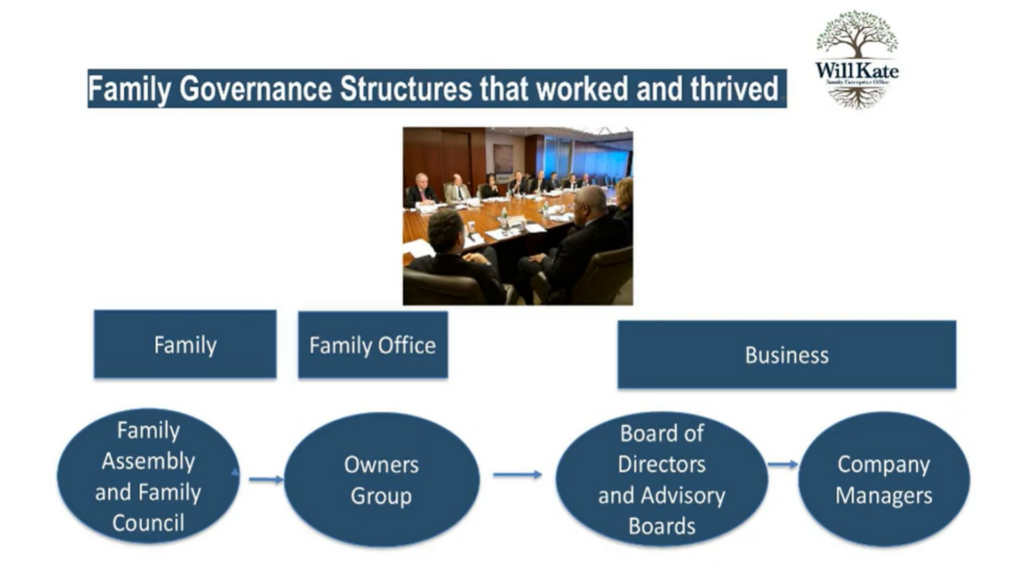
As we embark on 2022 and beyond, family enterprises have the opportunity to re-imagine why and how they do business. With purposeful planning, many constructive ways exist to move forward from where you are today to create a sustainable family enterprise in a post-pandemic world.
To set perspective for the future it helps to take a look at the challenges family enterprises faced in 2020 and into 2021:
- Fear and no control on the threat
- Risk tolerance of senior generation
- Next Gen leaders’ preparation in turbulent times
- Resilience and rising up
- Communication decreased
- Loss of loved ones
- Employees with children out of school
- Emotional drain
- Business supply chain
- Rising business costs
What did we see families do to mitigate some of these challenges?
- Increased time together and communication
Rather than separate, families came together more, even if it was online. They were able to revisit their “why” and purpose again.
- Developed governance structures
Families looked at the governance structures to make sure it was effective and talked about the “what if’s” of the world.
- Increased intentional focus on strategic planning and new opportunities for diversification
There was a tremendous amount of shift on what their focus was – whether real estate, business or wealth diversification – to work on a 50 to 100 year view.
- Became disruptive innovators
They challenged how they were actually functioning. It wasn’t so much about “how do we stabilize”, but more about “how do we improve”, and how their belief systems and customer base influenced that.
- Became more comfortable with technology
Families realized the heavy dependence on virtual communication during the pandemic and started to look at reporting software and were excited about the efficiency that was created.
- Invested in the family and their business
There was a distinct difference here: investing in family was about how they were developing their talent pool. Investing in their business was about expansion instead of pulling back, which captured a lot of opportunities.
- Created an annual calendar
The calendar outlined all scheduled meetings, defining the purpose of each one along with articulating who was in charge. The expectations were set that everyone would show up, be prepared, and participate. All family members were included so everyone could be part of all that was transpiring.
We also found successful exercises for families to be able to move forward and make good decisions in uncertain times:
Clear Communication
- Affect Vs Effect – Those that reached out to customers/clients and focused on the relationships were able to influence the thinking and trust factor and have an AFFECT. There was also the way an outcome was triggered by something else and had an EFFECT, where the family business was run professionally and expected a return. Family communication should have both.
- Hearing Vs Listening – You can listen but you may not be able to hear. Listening skills were essential to effective communication and influenced all areas of governance.
- Resolving Conflict – When there is high-stress how do you resolve conflict in a respectful and effective way? We found this to be a very important piece to focus on getting through conflict when there is strong disagreements, even with governance structures in place.
- Being Effective Across Governing Bodies – If one conversation is in one area and not communicated to another this hierarchy would cause problems. This piece must be strong.
- Journaling – sometimes an outlet is important to express emotions as an effective tool to understand individual issues and then be able to have good communication with others.
We talked about family governance structures that worked and thrived:
An example is from a 3rd generational manufacturing company that was able to bring in spouses and the family of the next generation with their feedback and have conversations to move forward with opportunities and options for the company. This impacted their family council to create a successful family charter.

Another example is a family enterprise that had loose governance structures in place with outside committees and a focus on estate planning and had a lot of personal challenges. We started with their “why” and purpose – the foundational pieces to keep the heritage moving. We had them add in outside members and do cash-flow projections and professionalize a lot of the executive pieces so they could go beyond 100 years.
In both these examples it shows the importance of starting off with communication, bringing in other family members and focusing on the foundational pieces before moving into family governance structure.
Other integral pieces used to strengthen and grow the family enterprise in a post-pandemic world:
Family Council – Representing and addressing the ‘family” issues associated with the family enterprise and developing the family constitution, business culture and brand
Owner’s Manual and Owner’s Plan – All of the management’s plans and day-to-day operations to reflect the wishes of the owners
Boards and Advisory Boards – Accountability and responsibility for balancing the plans of the owners and management, as well as giving advice and preparing the next generation.
As a 3rd generation family business member with 8 siblings and 120 family members I know this work to be very important, especially focusing on communication and relationships so you can get through any challenge.
Coming from a place of heart as founder and owner of WillKate, a Family Enterprise Office, I bring, with the help of my team, a holistic approach to family and family resources.
Contact our office for a free consultation. We’d love to help you build lasting wealth. Simply email Somer Schimke at somers@will-kate.com or call Somer at 605-262-0308 and schedule a meeting for you and Aggie.
